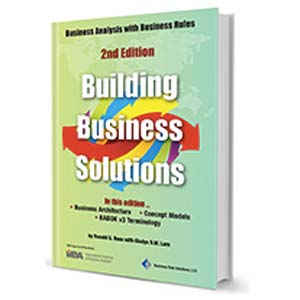Ruling in Favor of MQSeries Integrator
For this edition of Technology Review, I asked IBMís Mark Cousins and Leif Davidsen to describe how business rule technology helps IBMís MQSeries Integrator product.
Ruling in favor of MQSeries Integrator
Business today is faced with a faster pace of change than at any time in history. And thereís no sign of it slowing down. The globalization of markets, increasing competition and the arrival of the Internet and e-commerce have all combined to increase the pressure to be more responsive to customers and the business environment. That pressure falls most heavily on people who depend on Information Technology (IT) to respond quickly to change.
More than ever, there is a need to integrate and align IT with business strategy. IBMís MQSeries Integrator does just that.
Business integration is key
MQSeries Integrator is designed to handle the issues that have conspired to drag down the speed of ITís response to business change and the adoption of e-business.
A big inhibitor to rapid reaction is systems diversity. No business of any size is built on a single computing platform. Different functions have built their own solutions. Overcoming the integration of the different islands of automation has been a major headache for IT departments everywhere. Integration is key to current business issues like mergers and acquisition, Customer Relationship Management, Enterprise Resource Planning, and so on.
Think about a simple order taken over a web site. It sets off a chain reaction within the enterprise and across the trading partner network -- through the inventory systems, pricing, fulfillment, manufacturing -- across the whole supply chain. A fully integrated business will have in place all the processes and applications linked to support the immediate, seamless, frictionless movement of critical business information and transactions. This not only includes the processes and transactions within enterprises, but also the business-to-business (B2B) linkages.
Linkages, linkages and yet more linkages. As processes and applications are integrated, the point to point linkages can become a tangled and complicated maze of connections. Each one individually crafted to take account of the technology at their end. Each application program is painstakingly modified each time the business or system configuration changes.
The MQSeries Integrator solution
It need not be like this. MQSeries Integrator untangles the connections and frees the applications from the constraint of recognizing the technicalities needed to connect to other applications.
With MQSeries Integrator, itís simple to specify how information can be used to automate processes, supply people with tailored information for their job, and change the links between activities to create new business processes. It works with dynamic access to information, so you can use your data in new and creative ways, without having to worry about incompatibilities.
Integration of applications by exchanging business data is key to the flexibility required for e-business. MQSeries Integrator handles it this way: When an application needs to exchange information with another application (this is called messaging), it just has to define the application that is the target, and the information to be sent. Neither application needs to know any technical details of the other. MQSeries Integrator, using business rules and logic, and transforming the information to the format required by the receiving application intelligently routs the information to its destination.

MQSeries Integrator is built on IBMís award-winning MQSeries (the messaging technology) but provides additional value. A formatter transforms messages to make sure they match across applications. A rules database is included which allows you to define what happens based upon the content of a message. From the content, messages are routed appropriately.
MQSeries Integrator can transform XML representations, in your order entry form, for example, into something immediately understandable to packaged applications, like a stock management application.
Defining rules is simple
The goal in MQSeries Integrator was to eliminate programming from the definition of rules and transformation formats, so that they could be defined by a non-programmer or a technically orientated business person. After all, theyíre the ones who know what the process should do. To accomplish this, MQSeries Integrator contains a powerful new GUI-based tool. This means that itís fast.
The tool uses a drag-and-drop operation. Itís like using Microsoft PowerPoint or Lotus Freelance, with a palette of objects and a working area where the objects, like information elements and rules, can be compiled and wired together into process flows.

The tool has an open specification, with a published interface that vendors can use to produce process steps in the message flow called message-processing nodes. In addition, rules and process nodes can be aggregated into objects that can be used in higher level flows, simplifying and hiding complexity.
Think about the possibilities... a business analyst can make rule updates to react to market changes instantly using a rich set of vendor plug-ins to help create powerful process nodes. This is a powerful way of exploiting new opportunities or reacting quickly to change.
Building rules with MQSeries Integrator
The message flow defines the operations carried out on the message from its entry to the broker through to the message or messages that it outputs. Steps in the flow, or process nodes, can transform a message from one format to another, access a database to enrich a message, perform archiving, encryption, and so on.
A process node is a well-defined processing stage, coded to perform a specific task, or set of tasks on a message flowing through the broker. A selection of predefined nodes comes supplied with the MQSeries Integrator product, including the Formatter and Rules Nodes; both from IBMís Business Partner NEON. Additional nodes can be created and plugged-in.

The diagram shows an example message flow, which can be considered as one step in a larger workflow. The example is taken from a paper called "IBM MQSeries Integrator V2 - The Next Generation Message Broker", by Jay H. Lang, Chief Technologist, Distributed Computing Professionals. You can find the paper at the IBM MQSeries Website: http://ibm.com/software/ts/mqseries/library/
In this example, a message is sent to MQSeries Integrator from a client application. The system handles logistics services for the airline industry. The message contains a rush order for an engine part for a Boeing 737 to be sent to Londonís Heathrow airport.
|
A
An important point to note about message flows is they can be transactional. In other words, either the whole flow completes successfully, or none of it completes. This means that data held in the systems is always valid, and there are no loose ends. Transactional integrity like this is vital for any type of business, but especially for e-business.
Message transformation and templates
Transformation is important because of the way that applications work. Most enterprises have applications that have developed over the years, on different systems, using different programming languages and different methods of communication. Standard MQSeries message queuing technology can bridge differences like these, but each message queue has to be explicitly told about the characteristics of each message destination.
MQSeries Integrator changes all that. The knowledge of each application is stored just once in the hub and, while intelligent routing decides where each message is to go, it is translated into the appropriate format. For instance, personal names are held in many forms in different applications. Surname (a.k.a. last name or family name) first or last, with or without middle initials, upper- or lowercase; these are just some of the permutations. Supplied with the information definition of each application, the transformation engine can supply data in the right format to any receiving application, without the sending application needing to be modified in any way.
Many enterprises make use of packaged applications, like PeopleSoftís GL, and SAP R/3. Packages like these make use of hundreds of different forms, which contain information relating to specific transactions that are handled by the applications. Application templates encapsulate knowledge of all the data that is carried in the forms, to make it easy for other (non-packaged) applications to gain access to the information that is in the forms. Used in conjunction with transformation and intelligent routing where necessary, application templates ensure that information flow can encompass every type of application in the enterprise, both packaged and custom-made.
Additional templates are also available for protocols like Electronic Data Interchange (EDI) and S.W.I.F.T. (the financial network). Even more templates will be available in the future to ensure simple integration with popular packages and protocols.
|
In summary
MQSeries Integrator builds on the industrial strength capabilities of MQSeries and offloads the information formatting and routing requirements from your application programs. This gives you a rules-based business focus on exploiting the assets of the entire business, leading to increased competitive advantage without the need for radical changes to the IT infrastructure.
Most importantly, MQSeries Integrator helps make your business run faster and more responsively. It makes it easy for you to align your IT resources with business strategy, and your IT infrastructure becomes more adaptive to change.
Where to find out more: http://ibm.com/software/mqseries
| About the authors. . . |
|
If youíre using a Business Rules product or tool, you can submit your own evaluation of the product and weíll post it on our web site. Additionally, if you would like to see a write-up of a particular tool, let me know. My email address is
nfishman@brcommunity.com
About our Contributor:
Online Interactive Training Series
In response to a great many requests, Business Rule Solutions now offers at-a-distance learning options. No travel, no backlogs, no hassles. Same great instructors, but with schedules, content and pricing designed to meet the special needs of busy professionals.



 Leif
Davidsen
works in the MQSeries Business Unit as the Technical Evangelist for
MQSeries Integrator. He has worked in IBM Hursley for more than 10
years in a variety of technical and managerial roles spanning both
CICS and MQSeries products.
Leif
Davidsen
works in the MQSeries Business Unit as the Technical Evangelist for
MQSeries Integrator. He has worked in IBM Hursley for more than 10
years in a variety of technical and managerial roles spanning both
CICS and MQSeries products.








